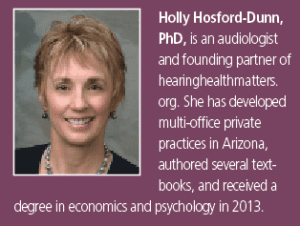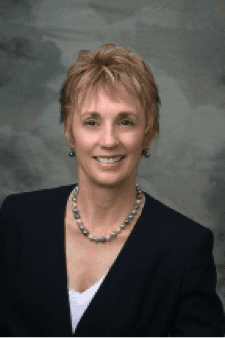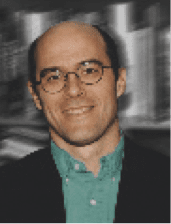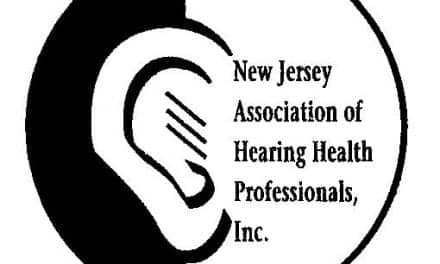Hearing Review September 2014
By Holly Hosford-Dunn, PhD
This blog is adapted from Holly Hosford-Dunn’s August 5, 2014 Hearing Economics: HearingHealthMatters.org. — David Kirkwood, HHM Editor
Last post (July 29, 2014 Hearing Economics Blog) introduced Tom Northey and his 2000 AudiologyOnline article1 in which he predicted that today’s audiologists would fall into camps of survivors or scatter to the wind as competitive forces eased out the losers. Today’s post is for those interested in operating in survivor mode.
Northey contrasted audiology to optometry in the 1970s, speculating that disruptive technologies in vision care back then (eg, disposable contact lenses or DCLs) could emerge in hearing care in the 21st century. The current discussion excerpts Northey’s writing and continues his comparative model by applying the historical vision template to the sale of hearing devices (hearing aids and PSAPs) via Big Box, Internet, traditional, and other means in today’s market.
Optometrists and Audiologists
Northey witnessed the changing roles of optometrists as they were diverted or eliminated from the dispensing equation:
The distribution system of DCLs is another corporate invention. Today you can pick up your groceries, four quarts of motor oil, your monthly supply of Prozac, and a month’s supply of contact lenses at any “super” discount chain. If your prescription is current (usually 6 months to a year with an eye exam) you can add your DCLs to your shopping cart. Manufacturers of DCLs have discovered it is even more profitable to place a dispensing optometrist in a given discount chain store at no cost to the individual store. The payoff is in the quantity of units sold. Manufacturers realized that convenience and price are the primary drivers for customer purchase decisions regarding disposable products.1
And so it has come to pass for audiologists as well, not only due to Big Box chains like Costco, but also to electronic shopping carts on the Internet and one-stop mail-order shopping through health insurance companies. Prescriptions are easily waived or unnecessary in the case of PSAPs. Ditto for audiograms. Most Big 6 manufacturers have discovered the volume-driven profitability of dispensing in Costco and other discount chain stores. Manufacturers realized that convenience and price are the primary drivers for customer purchase decisions regarding ear devices.
Saving Graces and the Big Picture
Optometrists had a few tricks up their sleeves that audiologists are lacking, but they still had to scramble as we do now:
What saved the optometrist? Some of it is luck, specifically the development of corrective vision surgery and the aging and emergence of the Baby Boomer into the vision correction market. PRK, and the more recent Lasik procedure, emerged at about the time when the DCL market started moving into full force. Wise optometrists quickly formed working relationships with ophthalmologists. This new referral-based revenue stream helped recover some of the revenues lost to DCLs.
Today, optometrists have to be knowledgeable business-wise practitioners. With DCLs becoming “loss leader” products…[they] have had to re-think and re-tool their professional offering. Everything from services to products has been re-examined.
The successful optometrist no longer treats only eye diseases and vision impairment. The successful optometrist offers total vision services: Reading skills, vision training for athletes (eye & hand coordination), sunglasses, glasses, anti-glare products, specialized testing, all offered in addition to their core mix of products and services. Most optometrists charge for every possible type of appointment (eye exams, follow-up visits, etc).
The clinical staffing model has changed as well. Thriving optometry practices today are no longer groups of degreed optometrists—they simply can’t justify the salaries. Clinics today have one optometrist (usually the owner/partner) with technicians performing most of the tests. The optometrist typically makes a 5-10 minute visit to the patient to verify the results and to prescribe the treatment. Optometrists today typically see 30-40 patients a day.1
Luck has not been a lady to Audiology in recent years. Unlike vision care, no corrective hearing surgeries have come our way, nor has alignment with ENTs produced many lasting and meaningful relationships, much less relationships of equality. Oh, well. As in vision care, licensed providers, audiologists, must be knowledgeable and business-wise, offering and expanding full, unbundled services in hierarchical models of service delivery.
Northey saw it this way back in 2000, when he addressed the bigger picture:
It is prudent to maintain the policy of charging set fees for office visits and services, rather than bundling the service and professional fees into the cost of the product. This ensures that whatever the change in the product, your practice remains solvent and credible…
I believe audiologists should view themselves as being in the communication business, not just the hearing aid business. This lesson, also referred to as “seeing the big picture,” was exemplified by the narrow focus and tunnel vision which destroyed the streetcar industry and almost destroyed the railroad industry. Rather than viewing themselves as transportation businesses, they viewed themselves within the constraints of their least common denominators.1
These words from Northey echoed those of Earl Harford, PhD, who warned audiologists in 1993 that we must define our professional selves beyond the hearing aid. I doubt that Harford saw us going the way of streetcars, but I believe he shared Northey’s view that dumbing ourselves down to our lowest common denominator—the equivalent of one-trick ponies—was not a survival strategy.
Most present-day audiologists who look at their accounting books can be excused for asking the obvious question: “If not hearing aids, then what?” We’ll look at that in the next Hearing Economics blog.

Reference
- Northey T. Issues regarding disposable hearing aids. July 4, 2000. Available at: http://www.audiologyonline.com/articles/issues-regarding-disposable-hearing-aids-1288
Original citation for this article: Hosford-Dunn H. Survival of the fittest audiologists. Hearing Review. 2014;21(9):12.





